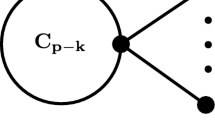Abstract
The Hom complex of homomorphisms between two graphs was originally introduced to provide topological lower bounds on the chromatic number. In this paper we introduce new methods for understanding the topology of Hom complexes, mostly in the context of Γ-actions on graphs and posets (for some group Γ). We view the Hom(T, ⊙) and Hom(⊙, G) complexes as functors from graphs to posets, and introduce a functor (⊙)1 from posets to graphs obtained by taking atoms as vertices. Our main structural results establish useful interpretations of the equivariant homotopy type of Hom complexes in terms of spaces of equivariant poset maps and Γ-twisted products of spaces. When P:= F(X) is the face poset of a simplicial complex X, this provides a useful way to control the topology of Hom complexes. These constructions generalize those of the second author from [17] as well as the calculation of the homotopy groups of Hom complexes from [8].
Our foremost application of these results is the construction of new families of test graphs with arbitrarily large chromatic number—graphs T with the property that the connectivity of Hom(T,G) provides the best possible lower bound on the chromatic number of G. In particular we focus on two infinite families, which we view as higher dimensional analogues of odd cycles. The family of spherical graphs have connections to the notion of homomorphism duality, whereas the family of twisted toroidal graphs lead us to establish a weakened version of a conjecture (due to Lovász) relating topological lower bounds on the chromatic number to maximum degree. Other structural results allow us to show that any finite simplicial complex X with a free action by the symmetric group S n can be approximated up to S n -homotopy equivalence as Hom(K n ,G) for some graph G; this is a generalization of the results of Csorba from [5] for the case of n = 2. We conclude the paper with some discussion regarding the underlying categorical notions involved in our study.
Similar content being viewed by others
References
E. Babson and D. N. Kozlov, Group actions on posets, Journal of Algebra 285 (2005), 439–450.
E. Babson and D. N. Kozlov, Complexes of graph homomorphisms, Israel Journal of Mathematics 152 (2006), 285–312.
E. Babson and D. N. Kozlov, Proof of the Lovász conjecture, Annals of Mathematics 165 (2007), 965–1007.
G. R. Brightwell and P. Winkler, Graph homomorphisms and long range action, in Graphs, Morphisms and Statistical Physics, DIMACS Series in Discrete Mathematics and Theoretical Computer Science, Vol. 63, American Mathematical Society, Providence, RI, 2004, pp. 29–47.
P. Csorba, Homotopy types of box complexes, Combinatorica 27 (2007), 669–682.
P. Csorba, Fold and Mycielskian on homomorphism complexes, Contributions to Discrete Mathematics 3 (2008), 1–8.
A. Dochtermann, Hom complexes and homotopy theory in the category of graphs, European Journal of Combinatorics 30 (2009), 490–509.
A. Dochtermann, Homotopy groups of Hom complexes of graphs, Journal of Combinatorial Theory. Series A 116 (2009), 180–194.
A. Dochtermann, The universality of Hom complexes, Combinatorica 29 (2009), 433–448.
A. Gyárfás, T. Jensen and M. Stiebitz, On graphs with strongly independent color-classes, Journal of Graph Theory 46 (2004), 1–14.
S. Hoory and N. Linial, A counterexample to a conjecture of Björner and Lovász on the χ-coloring complex, Journal of Combinatorial Theory. Series B 95 (2005), 346–349.
G. M. Kelly, Basic Concepts of Enriched Category Theory, London Mathematical Society Lecture Note Series, Vol. 64, Cambridge University Press, Cambridge, 1982.
D. N. Kozlov, Chromatic numbers, morphism complexes, and Stiefel-Whitney characteristic classes, in Geometric Combinatorics, IAS/Park City Mathematics Series, Vol. 13, American Mathematical Society, Providence, RI, 2007, pp. 249–315.
L. Lovász, Kneser’s conjecture, chromatic number, and homotopy, Journal of Combinatorial Theory. Series A. 25 (1978), 319–324.
J. Matoušek, Using the Borsuk-Ulam Theorem, Universitext, Springer-Verlag, Berlin, 2003. Lectures on topological methods in combinatorics and geometry, Written in cooperation with Anders Björner and Günter M. Ziegler.
J. Nešetřil and C. Tardif, Duality theorems for finite structures (characterising gaps and good characterisations), Journal of Combinatorial Theory. Series B 80 (2000), 80–97.
C. Schultz, Graph colorings, spaces of edges and spaces of circuits, Advances in Mathematics 221 (2009), 1733–1756.
C. Schultz, A short proof of w n1 (Hom(C r+1,K n+2)) = 0 for all n and a graph colouring theorem by Babson and Kozlov, Israel Journal of Mathematics 170 (2009), 125–134.
G. Simonyi and G. Tardos, Local chromatic number, Ky Fan’s theorem and circular colorings, Combinatorica 26 (2006), 587–626.
C. Tardif, Fractional chromatic numbers of cones over graphs, Journal of Graph Theory 38 (2001), 87–94.
R. T. Živaljević, WI-posets, graph complexes and ℤ2 -equivalences, Journal of Combinatorial Theory. Series A 111 (2005), 204–223.
R. T. Živaljević, Combinatorial groupoids, cubical complexes, and the Lovász conjecture, Discrete & Computational Geometry 41 (2009), 135–161.
Author information
Authors and Affiliations
Corresponding author
Rights and permissions
About this article
Cite this article
Dochtermann, A., Schultz, C. Topology of Hom complexes and test graphs for bounding chromatic number. Isr. J. Math. 187, 371–417 (2012). https://doi.org/10.1007/s11856-011-0085-6
Received:
Revised:
Published:
Issue Date:
DOI: https://doi.org/10.1007/s11856-011-0085-6




